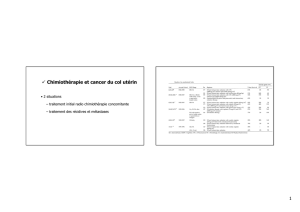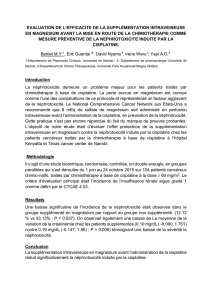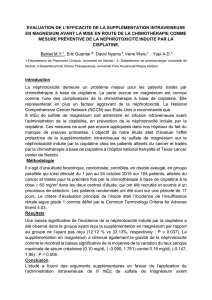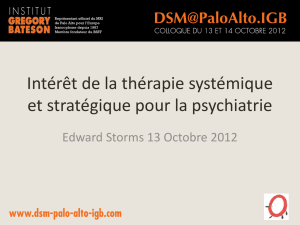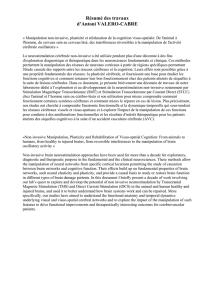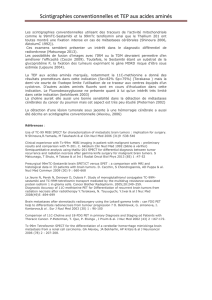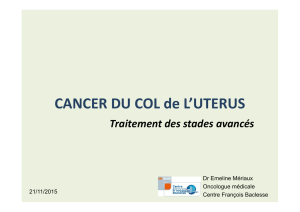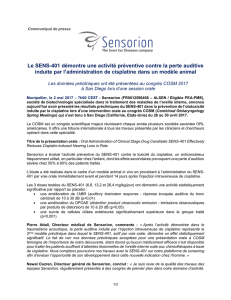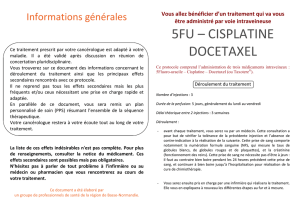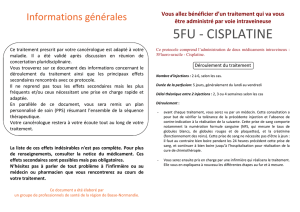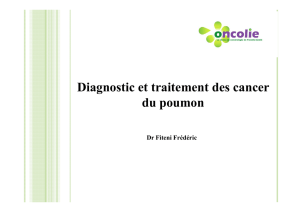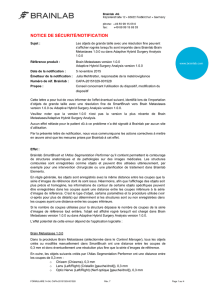Place of chemotherapy in the management of brain metastases
publicité
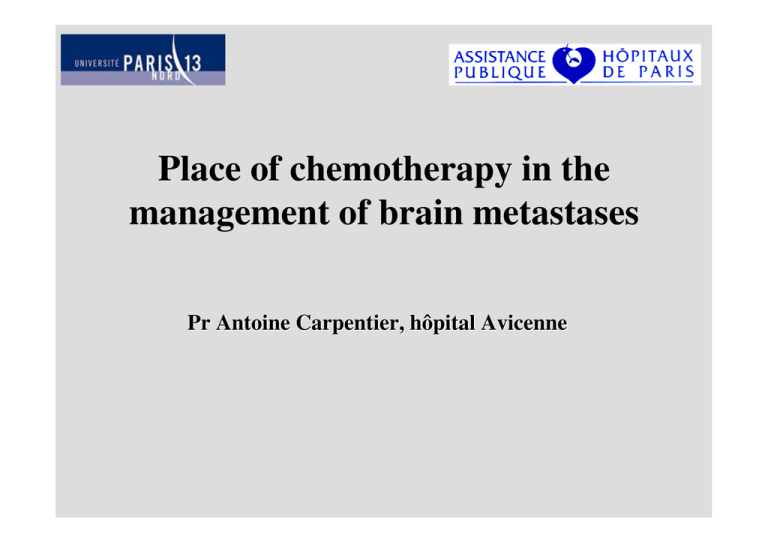
Place of chemotherapy in the management of brain metastases Pr Antoine Carpentier, hôpital Avicenne 42-yr old nurse March 2011: Headaches MRI: (16/3/2011) : 2 cerebellar lesions CT scan + PET FDG: one mediastinal adenopathy echo-endoscopy biospy: lung adenocarcinoma Mutated EGFR ⇒ sensitivity to erlotinib/gefitinib Oncological Managment of brain metastases: 2 cases Metastase eligible for surgical resection or radiosurgery #10% Metastase non eligible for surgical resection or radiosurgery #90% Surgical resection or Radiosurgery ? • Surgery if • size> 35mm • If histology required • Radiosurgery if • Size < 30mm • Up to 3 (or 4) metastases Managment of brain metastases: 2 cases Metastase eligible for surgical resection or radiosurgery Metastase non eligible for surgical resection or radiosurgery Whole brain radiotherapy (WBRT) standard protocol = 30 Gy in 10 fractions /12 days radiological response rate: # 30% in NSCLC # 50% in breast cancer Metha, 2003 ; Stea, 2006 ; Suh, 2006 La chimiothérapie peut elle être une alternative? accès de la molécule à la métastase: « La BHE est le problème » BHE est elle vraiment fonctionnelle? Structure of Blood Brain Barrier 1. Endothelium a. tight intercellular junctions b. relative lack of vesicular transport 2. Pericytes with smooth muscle- like properties 3. Astroglial process ( >95% of the luminal vessel surface) Deeken et al. Clin Cancer Res, 2007. BBB composition Protein components: – Claudin & Occludin heterodimer (no occludin Breakdown of BBB) – Junction Adhesion Molecules (Ig superfamily) : cell-to-cell adhesion and leukocyte transmigration through BBB – Accessory proteins (ZO-1, ZO-2, ZO-3, cingulin, MAGUKS ) Ballabh et al Transports • Diffusion : pour les petits composés (< 400 Da), apolaires et lipophiles • Transports actifs : composés polaires et hydrophiles • transporteurs d’efflux Deeken et al. Clin Cancer Res, 2007. Les transporteurs d’efflux -La P-glycoprotéine (P-gp) encore appelée ABCB1, MDR1 - Multidrug Resistance-associated Proteins (MRP) de la famille ABCC (MRP1 à MRP9) - Breast Cancer Resistance Protein (BRCP), encore appelée ABCG2 - Les transporteurs d’anions (OAT) et de cations (OCT) organiques Deeken et al. Clin Cancer Res, 2007. Les transporteurs d’efflux Unidirectional Drug Transport at the BBB BBB Blood CSF Pgp Compound Efflux Transporteurs et spécificités de substrats Les transporteurs d’efflux composant la BHE et les agents chimiothérapeutiques Transporteur P-glycoprotéine Nom HUGO Substrats ABCB1 Doxorubicine, daunorubicine, docetaxel, épirubicine, idarubicine, vinblastine, étoposide MRP1 ABCC1 Etoposide, teniposide, daunorubicine, doxorubicine, épirubicine, melphalan, vincristine, vinblastine MRP2 ABCC2 Similaire au MRP1 MRP3 ABCC3 Similaire au MRP1 MRP4 ABCC4 Méthotrexate, 6-mercaptopurine, thioguianine MRP5 ABCC5 6-mercaptopurine, thioguianine MRP6 ABCC6 Actinomycine D, cisplatine, daunorubicine, doxorubicine, étoposide BCRP ABCG2 Mitoxantrone, méthotrexate, SN-38, topotecan, imatinib, erlotinib, gefitinib gène MDR1 Deeken et al. Clin Cancer Res, 2007. Principales chimiothérapies passant la BHE Alkylants • Nitrosourées (BCNU, CCNU) • Témozolomide • Procarbazine 15-30% 20-30% • Sels de Platine (Carboplatine, CisPlat) <5% Autres • Poison Fuseau mitotique (vincristine) • Inhib Topo 2 (Etoposide) • Capecitabine (Xeloda) 1% 1-5% TKI and the blood-brain-barrier CSF studies (mainly in tumoral meningitis) (Jackman 2006; Masuda 2011) - CSF levels < 10% serum levels - Erlotinib > Gefitinib? - Pulsatile high dose regimen? (Grommes 2011) PET studies in 2 pts: Erlotinib accumulation in brain metastases (Weber, 2011) Alterations of the BBB - Tumor itself - Radiation - high blood pressure - Trauma, Ischemia, Inflammation, Infection Métastases cérébrales HER2+ 89Zr-Herceptin immunoPET Dijkers et al. Journal of Clinical Oncology, 2007 Clin K Res 2010 Augmentation de la perméabilité : • Rapide avec une radiothérapie à simple dose (une fraction de 20 Gy)1 Perméabilité (×10-7 cm/s) Radiothérapie Encéphalique in toto Avant • Retardée avec une radiothérapie à dose fractionnée (une fraction de 2 Gy 5 fois/semaine durant 4 semaines)2 Perméabilité (×10-7 cm/s) Temps après irradiation (h) Jours après début d’irradiation (1) Yuan et al. Brain Research, 2003 (2) Yuan et al. International Journal of Radiation Oncology, 2006 Drug delivery through the BBB • [intracerebral injections ] • Pharmaceutic disruption of the BBB : – osmotic means (IV Mannitol) – vasoactive substances such as RMP-7 (bradykinin agonist) – blocking of active efflux transporters – localized exposure to ultrasound • transport systems: – Carrier/ receptor-mediated transcytosis (for ex transferrin receptors) – nanoparticles / liposomes Chemotherapy and brain metastases Non small cell Lung cancer No previous chemotherapy No previous radiotherapy Auteurs date chimiothérapie n RR cérébrale Thomas 1990 cisplatine 30 27% Minotti Crino Franciosio Fugita Robinet Cortes Cortot Barlesi Bailon 1998 1999 1999 2000 2001 2003 2006 cisplatine + téniposide cisplatine + gemcitabine cisplatine + étoposide cisplatine + ifosfamide + irinotecan cisplatine + vinorelbine cisplatine + Taxotère + vinorelbine/gemcitabine cisplatine + TMZ 23 26 43 30 86 25 50 35% 41% 30% 50% 27% 38% 12% 2011 Cisplatine+Alimta 43 42% 2012 Carboplatine+Alimta 30 40% platine + others Brain metastases are chemosensitive 32% RR systémique 26% 37% 62% 35% 50% 12% 33% Chemotherapy and brain metastases Non small cell Lung cancer No previous chemotherapy No previous radiotherapy RR systémique Auteurs date chimiothérapie n RR cérébrale Thomas 1990 cisplatine 30 27% Minotti Crino Franciosio Fugita Robinet Cortes Cortot Barlesi 1998 1999 1999 2000 2001 2003 2006 cisplatine + téniposide cisplatine + gemcitabine cisplatine + étoposide cisplatine + ifosfamide + irinotecan cisplatine + vinorelbine cisplatine + Taxotère + vinorelbine/gemcitabine cisplatine + TMZ 23 26 43 30 86 25 50 35% 41% 30% 50% 27% 38% 12% 2011 Cisplatine+Alimta 43 42% 62% 35% 50% 12% 35% 32% 33% Cisplatine + others Same chemosensitivity for brain/lung lesions 26% 37% Tyrosine kinase inhibitors (TKI) NSCLC + Brain metastases Treatment with TKI (upfront in #50%) Ref Kim Kim Porta TKI 2009 2010 (asco) 2011 n Brain RR Gefitinib or Erlotinib 23 74% Gefitinib 23 70% Erlotinib 17 82% Extra neural RR 70% 88% From Chiu et al, Lung Cancer 2005 42-yr old nurse Gefitinib 7 avril 2011 20 mai 2011 Courtesy of Dr A Augier, Hop Avicenne LANDSCAPE (phase IIa) - breast cancer exrpessing HER2 with brain metastases - n= 45 pts - previously treated with trastuzumab in 42 pts Ttt with Lapatinib + Capecitabine. Cerebral Response rate (≥50% reduction) = 67% Bachelot et al, ASCO 2011; abstr 509 Robinet et al, 2001 NSCLC No previous treatment Brain met Global PFS Chemotherapy alone 27% brain RR Chemotherapy + WBRT 33% brain RR survival CT: n=86 CT+RT: n=85 Timing of WBRT still difficult to define - no impact in NSCLC - positive impact in SCLC, especially in a prophylactic setting - Role of radiosensitivity? - Role of blood-brain-barrier (BBB) ? - macroscopic metastases, with disrupted BBB chemo alone? (with WBRT at relapse +++) - microsopic metastases, with intact BBB upfront WBRT ? Chemotherapy (and delayed WBRT) Need for randomized trial ++ Chemotherapy + WBRT Chemotherapy in a prophylactic setting? Brain metastasis Blood-brain-barrier 1ary tumor Tumor-Blood seeding Brain invasion & micrometastasis Brain metastasis Selection beyong the BBB stage IV melanoma, without evidence of CNS metastases - TMZ - Dacarbazine + Cisplatine + IL2 + Cisplatine + IL2 Cumulative incidence of central nervous metastases DTIC TMZ n= 74 n= 75 Survival Other targets Cancer Sci. Sci. 2004 Feb;95(2):142 Feb;95(2):142--8. Increased expression of integrin alpha3beta1 in highly brain metastatic subclone of a human non-small cell lung cancer cell line. Yoshimasu T, Sakurai T, Oura S, Hirai I, Tanino H, Kokawa Y, Naito Y, Okamura Y, Ota I, Tani N, Matsuura N. Nature, 2009 ….. Brain metastasis Blood-brain-barrier invasion 1ary tumor seeding angiogenesis Retrospective analysis of TARGET (phase III ): • renal carcinoma without CNS metastases • second-line treatment with Sorafenib (anti-VEGF, PDGF, Raf) In summary - Macroscopic Brain metastases are chemosensitive Respective place of Chemo/RT to be reconsidered - Prophylaxis of brain met by chemotherapy/targeted therapy? (especially in lung cancer, breast cancer, melanoma) A role for astrocytes ? BAT TUMOR GFAP Kim et al, Neoplasia, 2011 A role for astrocytes ? Kim et al, Neoplasia, 2011
